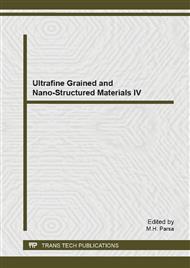p.530
p.534
p.539
p.544
p.549
p.554
p.559
p.563
p.568
Combustion Synthesis and Sintering of TiB2-Al2O3 Composites; Investigating the Effects of Different Al-Content as a Precursor
Abstract:
Titanium diboride (TiB2) ceramics have unique physical and chemical properties such as excellent electrical conductivity, high melting point and good corrosion resistance. But due to its relatively low sinterability, the use of this material is currently limited. The addition of Al2O3 to TiB2 can improve its fracture toughness, flexural strength, sinterability, and impact resistance. In this paper, TiB2-Al2O3 composite powders were produced by self-propagating high-temperature synthesis (SHS) method with reductive process from H3BO3-TiO2-Al system. Aluminum and magnesium were used as reductive elements to provide sufficient heat as primary driving force to obtain TiB2-Al2O3 composite. Due to the lower energy release in using aluminum as the initiator of the SHS process, finer microstructure can be achieved. Different stoichiometric amounts of aluminum as precursor were added to the mixture to examine its effect on the reaction progress. To evaluate the complete chemical conversion of the reactants, X-ray diffraction (XRD) and field emission scanning electron microscopy (FESEM) analyses were carried out. The highest conversion ratio was obtained from the sample containing 1.2 stoichiometric amount of aluminum.
Info:
Periodical:
Pages:
549-553
Citation:
Online since:
November 2013
Authors:
Keywords:
Price:
Сopyright:
© 2014 Trans Tech Publications Ltd. All Rights Reserved
Share:
Citation:


